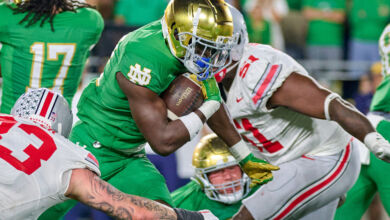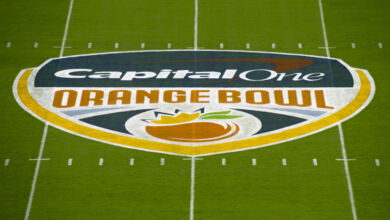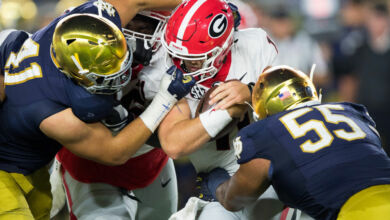
The story of Notre Dame football cannot be told without mentioning the legendary Four Horsemen. Harry Stuhldreher, Don Miller, Jim Crowley, and Elmer Layden formed a backfield so dominant that their names became synonymous with excellence in college football. Under the leadership of the visionary coach Knute Rockne, these four men led Notre Dame to an undefeated season in 1924 and cemented their legacy in sports history.
The Formation of the Four Horsemen
Knute Rockne’s ability to scout and recruit talent was unmatched, and this was evident in how he assembled the Four Horsemen. Rockne actively sought players who embodied a combination of athleticism, intelligence, and character. He believed in creating a team dynamic where players complemented each other’s skills.
- Harry Stuhldreher, the quarterback, was recruited from Massillon, Ohio. Stuhldreher was not just a skilled player but also a natural leader who would go on to serve as the team’s field general.
- Don Miller, hailing from Defiance, Ohio, was known for his speed and agility. He had been a standout high school athlete before joining Notre Dame, catching Rockne’s eye with his versatility on the field.
- Jim Crowley, a native of Green Bay, Wisconsin, was a player who thrived under pressure. Crowley’s recruitment came after Rockne saw his potential during a visit to Wisconsin, impressed by his quick decision-making and toughness.
- Elmer Layden, from Davenport, Iowa, was perhaps the most physically imposing of the four. Layden’s combination of size and speed made him a dual threat as both a runner and a defender.
Each player was handpicked for their unique abilities, but what truly made them special was how well they meshed as a unit. Rockne’s talent for seeing potential in young athletes and nurturing their development was key to building this legendary backfield.
The Historic 1924 Season
The 1924 season was a turning point for Notre Dame football and the Four Horsemen. The team dominated its opponents, showcasing a blend of athleticism, discipline, and tactical brilliance leading to the school’s first national championship. The most memorable moment of the season came on October 18, 1924, in a game against Army at the Polo Grounds in New York.
After a narrow 13-7 victory over Army, legendary sportswriter Grantland Rice immortalized the quartet in his famous opening line:
“Outlined against a blue-gray October sky, the Four Horsemen rode again. In dramatic lore they are known as Famine, Pestilence, Destruction and Death. These are only aliases. Their real names are Stuhldreher, Miller, Crowley and Layden. They formed the crest of the South Bend cyclone before which another fighting Army football team was swept over the precipice at the Polo Grounds yesterday afternoon as 55,000 spectators peered down on the bewildering panorama spread on the green plain below.
A cyclone can’t be snared. It may be surrounded, but somewhere it breaks through to keep on going. When the cyclone starts from South Bend, where the candle lights still gleam through the Indiana sycamores, those in the way must take to storm cellars at top speed. Yesterday the cyclone struck again as Notre Dame beat the Army, 13 to 7, with a set of backfield stars that ripped and crashed through a strong Army defense with more speed and power than the warring cadets could meet.
Notre Dame won its ninth game in twelve Army starts through the driving power of one of the greatest backfields that ever churned up the turf of any gridiron in any football age. Brilliant backfields may come and go, but in Stuhldreher, Miller, Crowley and Layden, covered by a fast and charging line, Notre Dame can take its place in front of the field. Coach McEwan sent one of his finest teams into action, an aggressive organization that fought to the last play around the first rim of darkness, but when Rockne rushed his Four Horsemen to the track they rode down everything in sight.
– Grantland Rice, New York Herald Tribune, 18 October 1924
Rice’s poetic description, combined with a photograph of the four players atop horses, turned them into national icons. The image and the accompanying narrative captured the imagination of the public, further elevating the profile of Notre Dame football.
The Role of the “Seven Mules”
The success of the Four Horsemen was not achieved in isolation. They were supported by an exceptional offensive line nicknamed the “Seven Mules.” This group of linemen cleared the path for the backfield, allowing them to execute Rockne’s innovative plays with precision.
The collaboration between the Four Horsemen and the Seven Mules exemplified teamwork at its finest. It highlighted the importance of every position on the field, demonstrating that even the most talented backfield requires a strong foundation to succeed.
The Rose Bowl Victory
The 1924 season culminated in a national championship, solidified by a decisive victory in the Rose Bowl. Notre Dame defeated Stanford 27-10, with the Four Horsemen delivering a masterful performance. The game not only crowned Notre Dame as national champions but also showcased the tactical genius of Rockne and the unrelenting skill of his players.
This victory marked Notre Dame’s first official national championship and firmly established the program as a powerhouse in college football.
Recruiting Challenges and Triumphs
Rockne’s recruitment of the Four Horsemen was not without its challenges. In an era before modern scouting systems and widespread media coverage, finding top talent required a keen eye and relentless determination. Rockne frequently traveled across the country, building relationships with high school coaches and families to ensure Notre Dame attracted the best players.
Convincing athletes like Stuhldreher, Miller, Crowley, and Layden to leave their hometowns and join a program in South Bend was no small feat. Rockne’s charisma and vision for Notre Dame football played a significant role in securing their commitments. He promised not only athletic success but also a chance to be part of something greater—a team that would define the future of college football.
Life After Football
After their playing days at Notre Dame, the Four Horsemen continued to leave their mark on the game. Each member pursued a career in coaching or sports administration, contributing to the growth and development of football.
- Harry Stuhldreher went on to coach at Wisconsin, where he became an athletic director.
- Don Miller chose a different path, pursuing a career in law but remained an advocate for sports.
- Jim Crowley achieved success as the head coach of Fordham’s “Seven Blocks of Granite” teams.
- Elmer Layden became the commissioner of the National Football League (NFL) and played a significant role in shaping the professional game.
Their collective contributions extended the legacy of the Four Horsemen far beyond their time at Notre Dame.
The Lasting Legacy
The Four Horsemen of Notre Dame are more than just a symbol of football excellence—they represent the enduring power of teamwork, innovation, and determination. Their achievements on the field and their contributions off it continue to inspire generations of players and fans.
From their iconic photograph to their historic 1924 season, the Four Horsemen remain a timeless chapter in the story of college football. Their legacy lives on, not only at Notre Dame but in the broader narrative of the sport.




From time to time, on the internet, I’ll see pictures of miniaturized versions of this famous statue. Does anyone have any idea if these can still be purchased and where/who from?
Does anyone know what the horses names were. That would be a great trivia question
The story of Rockne and his Four Horsemen is legendary.
One that has been passed on in film, literary expression, and father to son.
I never tire of hearing it told.
But I always end up thinking of the forgotten coach… Frank Leahy.
Talk about following in the footsteps, a tough act to follow, or playing second fiddle.
Leahy was a great coach in his own right but never seemed to recieve his well deserved recognition having coached the Irish so close to the recent memory and larger than life shadow of Rockne.
His .855 winning percentage over 11 season’s at ND is impressive, and largely overlooked.
He helped keep the ND football program viable during the war years.
(No easy task for any coach.)
I’d like to read more about Leahy. There is a great story there. One that should be told.
stick around Shaz
there’s a thing or two
coming on Leahy
Awesome article, duranko. I learned a lot about these icons.
Two quick reactions:
1) Rock didn’t start ND’s best players in ’24 ! ! !
Let’s build our depth so we can return to “shock troops” used regularly
e.g (like the third and 6th series in a game).
Wouldn’t that be a dynamite recruiting tool when you’d have a chance to play a lot just by being 2nd string!
2) Fun to learn about the “Horsemen’s” recruiting, and where they were from.
Let’s continue to build on last season and make more history.
Go Irish!
I did indeed learn more about Notre Dame’s Four Horseman. Exceedingly well written article duranko.
GooooooIrish!
I think Rockne was inspired by the Ziegfeld Follies to create the ND shift, not the Radio City Rockettes, but I could be wrong. Otherwise, a fantastic article.
EJS, great catch on the Ziegfield Follies! Of course you are right. let no scintilla of information on Rockne be incorrect! Thank you.
Thank you for your great work of research and love for Irish history.
Drop in a little Irish whiskey and you can almost hear Grantland Rice’s famous words.
“Notre Dame’s preeminence in the history of college football is no accident.”
A toast to “Our Lady”
Well you really raised the hair with that article professor, nice job…